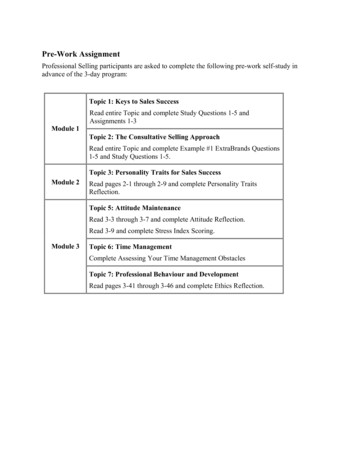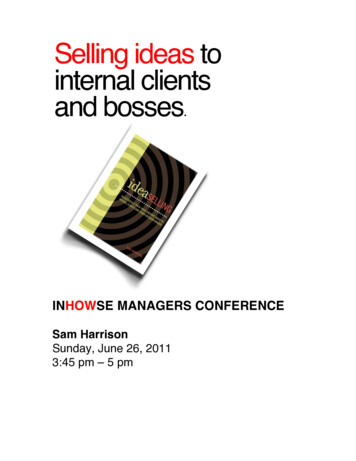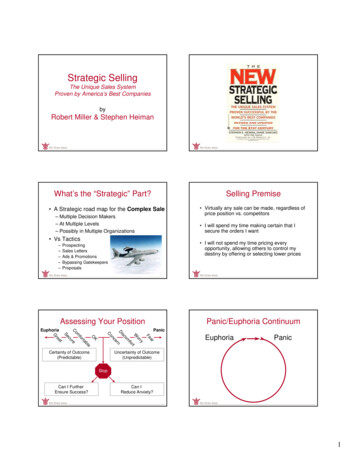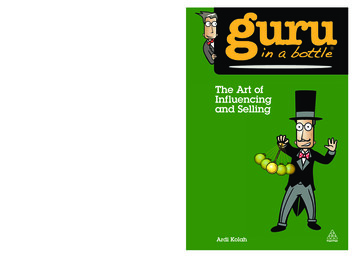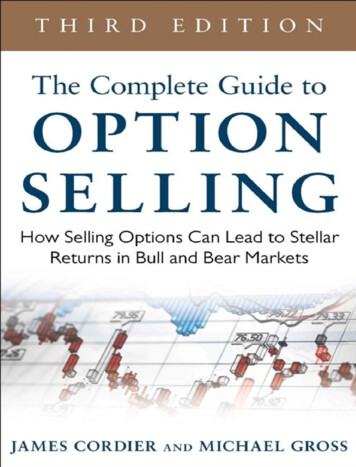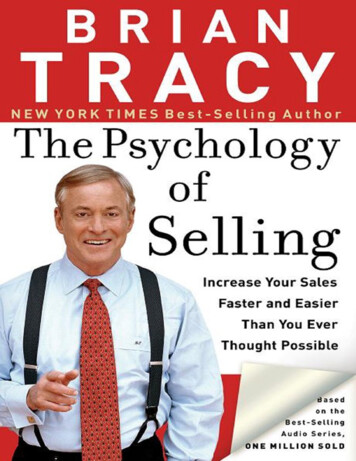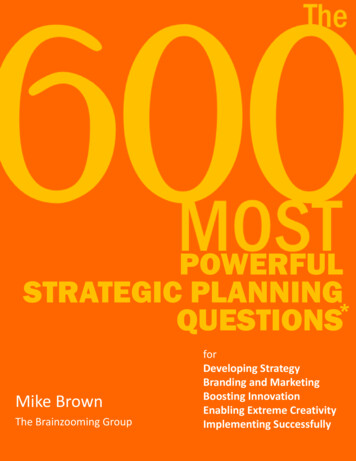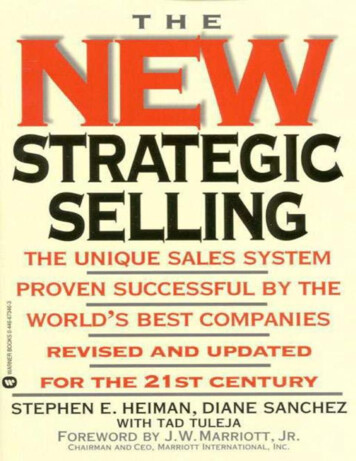
Transcription
STRATEGIC SELLING is a Service Mark of Miller Heiman, Inc., 1595Meadow Wood Lane, Suite 2, Reno, NV 89502All rights reserved. Without the written authorization of Miller Heiman, Inc., nopart of this book, whether text, diagram, chart or other illustration, and whetheror not it carries a further copyright notice, may be (i) reproduced in any form orby any means, electronic or mechanical, including photocopying, recording, orby any information storage and retrieval system; or (ii) utilized for any businesspurpose including, but not limited to, conducting any training seminar.Grand Central Publishing EditionCopyright 1998 by Miller Heiman, Inc.Copyright 1995 by Miller Heiman & Associates, Inc.Charts copyright 1998 by Miller Heiman & Associates, Inc.All rights reserved. Except as permitted under the U.S. Copyright Act of 1976,no part of this publication may be reproduced, distributed, or transmitted in anyform or by any means, or stored in a database or retrieval system, without theprior written permission of the publisher.This Grand Central Publishing edition is published by arrangement with WilliamMorrow and Company, 1350 Avenue of the Americas, New York, NY 10019Business PlusHachette Book Group237 Park AvenueNew York, NY 10017Visit our Web site at www.HachetteBookGroup.com.The Business Plus name and logo is a trademark of Hachette Book Group, Inc.First eBook Edition: March 1986ISBN: 978-0-446-54878-6
ContentsPREFACEFOREWORDIF IT AIN’T BROKE: THE “WHY” BEHIND THE NEW STRATEGICSELLINGPART 1: STRATEGIC SELLINGCHAPTER 1: SUCCESSFUL SELLING IN A WORLD OF CONSTANTCHANGECHAPTER 2: STRATEGY AND TACTICS DEFINEDCHAPTER 3: YOUR STARTING POINT: POSITIONCHAPTER 4: A GLANCE AT THE STRATEGY BLUEPRINT: THE SIX KEYELEMENTS OF STRATEGIC SELLINGPART 2: BUILDING ON BEDROCK: LAYING THE FOUNDATION OFSTRATEGIC ANALYSISCHAPTER 5: KEY ELEMENT 1: BUYING INFLUENCES
CHAPTER 6: KEY ELEMENT 2: RED FLAGS/LEVERAGE FROMSTRENGTHCHAPTER 7: BUYER LEVEL OF RECEPTIVITYCHAPTER 8: KEY ELEMENT 3: THE FOUR RESPONSE MODESCHAPTER 9: THE IMPORTANCE OF WINNINGCHAPTER 10: KEY ELEMENT 4: WIN-RESULTSPART 3: COMMON PROBLEMS, UNCOMMON SOLUTIONSCHAPTER 11: GETTING TO THE ECONOMIC BUYING INFLUENCE:STRATEGIES AND TACTICSCHAPTER 12: THE COACH:INFORMATION RESOURCEDEVELOPINGYOURPRIMECHAPTER 13: WHAT ABOUT THE COMPETITION?PART 4: STRATEGY AND TERRITORY: FOCUSING ON YOUR WINWIN CUSTOMERSCHAPTER 14: KEY ELEMENT 5: IDEAL CUSTOMERCHAPTER 15: YOUR IDEAL CUSTOMER PROFILE: DEMOGRAPHICSAND PSYCHOGRAPHICSPART 5: STRATEGYSELLING TIMEANDTERRITORY:MANAGINGYOUR
CHAPTER 16: OF TIME, TERRITORY, AND MONEYCHAPTER 17: KEY ELEMENT 6: THE SALES FUNNELCHAPTER 18: PRIORITIES AND ALLOCATION: WORKING THEFUNNELPART 6: FROM ANALYSIS TO ACTIONCHAPTER 19: YOUR ACTION PLANCHAPTER 20: STRATEGY WHEN YOU HAVE NO TIMECHAPTER 21: STRATEGIC SELLING: A LIFETIME APPROACHAFTER TWENTY YEARS: RESPONDING TO OUR CLIENTS’ MOSTCHALLENGING QUESTIONSAbout Miller Heiman
BUSINESS LEADERS AND THE PRESS PRAISESTRATEGIC SELLING“Even more timely and effective today than when The Dow Chemical Companyfirst adopted it in 1986.”—Gary Hardy, global leader of sales education and development, TheDow Chemical Company“The idea of playing Win-Win has helped us considerably in the sales processand also in our interoffice dealings with one another. No other principle hasimpacted us as much.”—Joe Dejohn, vice president, direct sales division, Atlet, Inc.“At Harris Corporation we have trained over 500 sales and marketing peopleworldwide on the original Strategic Selling concepts. Our old copies are wornout. The new and updated book is warmly welcomed. The old one helped us winmany multimillion-dollar orders, and I’m sure this new one will win even more.”—Carleton L. Smith, vice president, Asia sales and marketing, HarrisCorporation“A practical guide offering new insight into the way salesmen can successfullypromote big-ticket items to large organizations.”—Financial Post“A method that sales professionals can use effectively. The authors clearly and
engagingly describe numerous ‘workshops’ in which readers can apply their ownsales experiences. Professionally yet clearly presented.”—ALA Booklist“We quickly went from just a few thousand a month in sales to over 100,000 amonth. Strategic Selling gave us confidence in what we were doing. We peggedsome accounts as low probability, and even on those we were able to penetratedeeper and put our action plans into effect. We’ve been able to get a portion ofevery account out there.”—John Witkowski, director, Southeast business unit, AmershamHealthcare“The year after implementing Strategic Selling was our best sales year ever. Thisis the second full year we’ve been using the Miller Heiman processes, and we’regoing to come very close to doubling that.”—Roger Ballmer, manager, district marketing, Owen Healthcare, Inc.“The largest sale ever done at my previous position used Strategic Selling to winan extremely difficult and complex sale. The sale was over 5 million year oneand it continues to gross over 2 million a year for the past three years. Wecouldn’t have won it without the discipline and hard work of the team andcertainly not without the Miller Heiman course.”—Andrew Lee, vice president, sales and marketing, Microvision, Inc.“The best books I have read on selling.”—Scott DeGormo, Success magazine, on Strategic Selling and ConceptualSelling“Efficient, professional the finest high-level training program I have seen a mini-MBA in how to sell national accounts.”
—Henry J. Cockerill, former senior vice president, U.S.A. Fountain Sales,Coca-Cola Company“Thousands of HP sales engineers worldwide have been trained in StrategicSelling, and its influences can be directly seen in the results they have attained Its usefulness has spanned product disciplines and national boundaries.”—John A. Young, former president and chief executive officer, HewlettPackard Company“A totally professional planning process. If Willy Loman had taken the MillerHeiman program, he’d have been salesman of the year.”—Walter H. Drew, former senior vice president and general salesmanager, Consumer Products Division, Kimberly-Clark Corporation
PREFACEEvery year I meet or hear from dozens of graduates of Strategic Selling,Conceptual Selling, and other Miller Heiman programs. I also meet a lot of thesepeople face-to-face at places where I am speaking, giving a seminar, or on salescalls. Virtually all of them say the same thing to me. Invariably it is someversion of, “Bob, thank you so much for all the money you have made me overthe years! The greatest thing about Strategic Selling, and Conceptual Selling andLAMP is that they work!” Now I am as susceptible as the next guy to flatterylike this, and indeed it is very gratifying to hear this over and over again from somany alumni. But I always respond in the same way, “We appreciate the greatfeedback, but you are the one who had the discipline to apply it.” And thereinlies the key. Countless seminars are filled with ideas, some good and sound, andmany worthless nonsense. But no idea or concept is worth anything unless it canbe applied to situational reality. This has always been a planned hallmark ofMiller Heiman, Inc. programs. We can provide the knowledge and show ourparticipants how to do something, but the individual must deliver the discipline.Nor has it been just money that gives credit to Strategic Selling. Consider thestories of just a few of our alumni, of whom we are very proud: Mike Jackson, western region senior vice president and general managerfor General Motors, was the Coca-Cola account manager for Jack in theBox when he first was exposed to Strategic Selling in 1981. Rick Justice, executive vice president of worldwide operations at Ciscowas a twenty-two-year-old sales representative for Hewlett-Packard whenhe took Strategic Selling. He used the process on everyone of his dealsthat year, became Sales Representative of the Year, and the rest ishistory. Mike Cronk was a young district sales manager at Saga Food Service(now part of Marriott Sodhexo) when he ran Strategic Selling for his
district team. (Incidentally, it was the first seminar we ran for a Fortune500 company.) He just retired from being president of AramarkInternational. Reed Hilliard recently retired from a general manager’s position atAgilent Technologies. He was also a young newly appointed district salesmanager at Hewlett-Packard when he introduced Strategic Selling to histeam in 1976.These are but a handful of people who thank Strategic Selling for helpingtheir success over their careers. There are hundreds more.Next year will be the thirtieth anniversary of the first Strategic Sellingseminar. Of course, it wasn’t called that thirty years ago, and the exercises weresort of a “work-in-progress,” but you would recognize the same key principles:Win-Win, Four Buying Influences, Four Modes, Win-Results, Red Flags, IdealCustomer. These have all been concepts that distinguished Strategic Selling fromthe very beginning.Many alumni comment that the principles in our programs have stood the testof time. “Everything you teach in each program is as valid today as it was in1975, but more so. Why is that?” The fact that this is true is no accident. Thereason they have stood the test of time is each of the key ideas taught in allMiller Heiman programs, and in all of our books, relate a fundamental principleof the selling process. Note the two words emphasized in the previous phrase,principle and process. That is the secret to what makes Miller Heiman programsso practical and useful. And that was done by design. We have always focusedon teaching our participants the underlying principle instead of just thetechnique. If you learn only the technique without understanding why it works,you will soon forget it. If you understand the principle, you understand what itsplace is in the selling process and you will get more sales and better sales. Forexample, one technique taught in Strategic Selling is “Make sure you identifyand cover the bases with the Economic Buyer.” The principle underlying this is“There is one place and only one place wherein resides the final approval foreach sale.” In understanding that principle you now know why it is so importantto identify and cover that Economic Buyer base.Similarly, we focus on giving people principles that are part of a sellingprocess. Selling used to be looked upon as a haphazard, trial-and-error, fits-andstarts, luck-related type of venture. One of the key contributions StrategicSelling has made is to prove to salespersons and their managers that, whileselling is not a science, we can go about selling in a systematic way because
there are repeatable processes involved in both buying and selling. It does notrest upon fickle luck. A process is simply a systematic set of actions we take toachieve desired results. Having repeatable processes is what takes the trial anderror and guesswork out of life. Doctors have a very defined and systematicdiagnostic procedure to determine the cause of illness. IT programmers have asystematic step-by-step method for developing software. The beauty ofunderstanding and improving processes is that many, if not most, are universal,thus not dependent upon the specific knowledge and content of a particularsituation.Over the past thirty years I have been involved in coaching people in literallythousands of sales deals. I have helped Sikorsky Aircraft sell helicopters to theThai government; I have coached Hewlett-Packard to sell huge complexcomputer systems; I have helped Coca-Cola national accounts sell marketingprograms to Burger King; I have been involved in Cymer’s sales of its excimerlasers to Nikon and Canon and in Kimberley-Clark’s paper goods promotions toKroger; and so on. Am I an expert in helicopter technology? In computersystems? In consumer beverages? In consumer paper goods? Or in excimerlasers? Absolutely not! I only have a layman’s knowledge of each of these areas.I do have a systematic repeatable proven sales process in Conceptual Selling,Strategic Selling, LAMP, and our other process-based MHI programs. Thisprocess is applicable to all complex sales situations, so I focus upon the processsince I am not knowledgeable in all these industries. Another thing aboutunderstanding processes is that they are slow to become outdated if they areeffective processes. For example, the process for building a house is basicallythousands of years old. Even though the technologies have changed, the first stepis still to dig and lay a foundation, followed by framing of the outside walls andinterior support structure, followed by the gables and the roof, and so on. Dittofor the making of wine, thousands of years old.The third element is practice. Thirty years ago, the case study was theprimary learning tool for business and industry. I always felt that the weaknessin this approach when used in seminars was the transition from the case study toapplication in real life. So workshops to practice the principles and processes weespoused were built into all of our seminars from the very beginning. It is amethodology that has been much copied, but never matched in its effectiveness—learn the principle to understand why something works, learn the process stepto understand how to do it, and finally take a real-life situation upon which toplan and practice how to implement this to reality.Finally, now that I have talked about why it works, I want to talk about how itworks. When talking to prospective clients, I practice what I preach with this
Win-Win concept. I absolutely know that I ‘win’ when my customers get moreand better sales by using our programs. I get satisfied customers, repeat business,and referrals. However, I also let them know, that we cannot deliver the resultsalone. I can provide and teach the processes and the principles to theirsalespeople and managers, and even provide the practice. But they have toprovide the discipline that makes it work and gets the results. I urge clientmanagers to take a disciplined approach, which says, “This is the way we sell inthis company, and the expectation is that we will all do it this way. We willmake deals that are Win-Win for our customers and ourselves. We do not playWin-Lose. We have a plan before going on a sales call. We seek out coaching,and don’t close a deal until we have identified and covered bases with all buyinginfluences. We ask questions, probing to understand the real issues; we talk nomore than 20 percent of the time and listen 80 percent of the time. We try to findout what we don’t know. We look for Basic Issues. We do all of this because weknow that, if we do, we will have more sales and better sales and long-termcustomer relationships.” Corporate mandate, with the expectation that the rigorused day in and day out, is what engrains the process into corporate culture. Thisis the discipline of successful selling organizations!We know our processes and principles work. They have been proven in acrucible of reality for thirty years. You, our readers and clients, need to beprepared to provide the discipline to have your people use those principles andprocesses. It is our job to show you how, but we cannot do it for you. It isactually surprisingly simple: processes,principles, and discipline. We promise nomagic. There are no silver bullets to selling success. We both need each other.ROBERT B. MILLERSan Diego, CaliforniaSeptember 2004
FOREWORDMarriott International, Inc., has been fortunate to grow substantially over theyears, to the point where today it operates in fifty countries around the world andemploys over 200,000 people. Yet we remain in significant ways a familyorganization, still committed to the values that were honored by my parentsseventy years ago when they started in business with a tiny root beer stand.Among those values was a belief in the importance of relationships, bothwithin and outside the company. Since 1927, we have said that if you commityourself to taking care of your own people, you can be fairly confident that theywill take care of your customers. In a service business like ours, that is essentialto success. Marriott’s global reputation for quality and value is the direct resultof our honoring this principle. That same principle is the heart of The MewStrategic Selling.Throughout our history, we have found that our most productive businessalliances have been forged with companies that share this orientation. One of thestrongest of these has been with Miller Heiman, Inc., whose commitment to“Win-Win” relationships parallels our own. We have worked together since1986, when our company introduced its first sales associates to Miller Heiman’sStrategic Selling process. Since then, nearly a thousand Marriott people havebeen introduced to this process.There is a practical reason for this. In the past decade, we have expandeddramatically, in both our lodging and our contract services group, so that todaywe can offer our customers a wide variety of choices. In managing thecomplexity that naturally accompanies such expansion, Miller Heiman has beenan invaluable ally. Strategic Selling in particular has made importantcontributions to our position with business clients. In addition, Miller Heiman’ssystematic approach to managing change has helped to enhance our salesassociates’ flexibility as they keep pace with the rapid changes in our industry.
Aside from the practical benefits that Strategic Selling has brought us, Ibelieve that our association with Miller Heiman is strong because of the naturalfit between our companies. As we continue to expand toward our goal ofoperating 2,000 lodging properties by the year 2000, we remain committed to the“human side” of business. Miller Heiman understands and supports thatcommitment, and it’s once again evident in The New Strategic Selling.— J. W. Marriott, JR.Chairman and CEO,Marriott International, Inc.
IF IT AIN’T BROKE: THE “WHY” BEHIND THENEW STRATEGIC SELLINGStrategic Selling was first published in 1985. At that time, even though theprocess on which the book was based had been in place for only about eightyears, it had already begun to reap significant benefits both for our company,Miller Heiman, Inc., and for the clients who attended our Strategic Sellingworkshops and programs. In 1985, many of corporate America’s most successfulselling organizations had already begun to see us as the “process experts,” andwe had earned the trust of such innovative market leaders as Hewlett-Packard,Marriott, General Electric, Hallmark, and Coca-Cola.As we explained in the introduction to the original edition, we attributedmuch of our success with these and other forward-looking companies to ourimpassioned support of a non-manipulative selling philosophy that was thedriving force of the Strategic Selling approach. That philosophy was based onthe premise that getting an individual order is never enough: True selling successrests on such “beyond the order” achievements as repeat business, solid referrals,and long-term relationships. The key to securing them, we insisted, is to manageevery sales objective as a joint venture—a mutually beneficial transaction whereboth buyer and seller “Win.”In 1985, the notion of selling as a “Win-Win” process—indeed, the notion ofselling as a process at all—was still a novel approach to the profession. Evenamong companies who invested heavily in sales training, what was being taughtwas face-time skills and techniques—the traditional salesperson’s grab-bag ofhooks, lines, and clinchers. Manipulative tactics were still very much in vogue,and Miller Heiman was nearly unique among consultants in insisting that this
time-worn approach—the old “Get the order any way you can” approach—wasultimately a way of shooting yourself in the foot. Twelve years ago, if you talkedabout “serving your customer’s interests as well as your own,” many salespeoplestill considered you unrealistic. Everybody paid lip service to customer need, butout in the trenches, according to the given wisdom of the 1980s, it was stillnumbers, and orders, and hardball, that brought you success. There wassomething anomalous—some even said revolutionary—in the customer-orientedprocess of Strategic Selling.There was also something in it that was eminently practical—so practical thatour clients, who were already sales leaders, realized that it was a way to makethemselves even better. As “unrealistic” as traditionally trained salespeoplemight have considered our Win-Win approach, the incontrovertible fact was thatit worked. The proof of that could be seen in our clients’ financials, whichregularly reported major revenue gains that could be traced directly to theimplementation of our processes. It could be seen in the literally hundreds ofsuccess stories about how a “hopelessly confusing” account had begun to yieldsolid business once the sales team wrote a Miller Heiman-inspired action plan.As those stories poured in, and as our clients confirmed the contribution we weremaking, we were gratified to see that we had earned a reputation, in the words ofone divisional manager, as “the people who brought process into selling.”It was process, to be sure, that lay at the heart of our success, and that was thecase whatever in-house terminology our clients used. At Price Waterhouse, forexample, our systematic approach is called a “methodology.” At Coca-Cola, thepreferred term is “technologies.” Many of our other clients have adopted ourlanguage directly, speaking comfortably and naturally about Buying Influencesand Win-Results. Whatever the terms, the point is the same. The systematicapproach that we pioneered has fostered a quiet revolution among the nation’ssales leaders.We profited from that revolution as much as anyone. In a sense, by the timethe first edition of this book went to press, we had already become our own bestadvertisement. By running our own business on Strategic Selling principles, wewere increasing our revenues dramatically, year after year. Today, whilecountless companies are wrestling the downsizing dragon, Miller Heiman—likemost of our clients—is still on a roll. Over the past five years, for example, wehave increased our annual revenues by an average of 25 to 30 percent a year,tripled the staff in our corporate headquarters, and established offices from theUnited Kingdom and Brazil to Australia. Working with a sales force that hasquadrupled in a decade—not to mention hundreds of valued client associates—we have introduced over 150,000 sales professionals to one or more Miller
Heiman processes, and we continue to serve roughly 25,000 new ones everyyear.All of this has occurred, moreover, during a period of tremendousinternational turmoil, of dramatic fluctuations in government policies, and of abewildering “complexification” in selling itself. The world of sales has gonethrough a thousand major changes, but the processes we teach have been equalto the challenge. They’re still relevant, they still work, and they’re stillimproving the revenues of those who employ them. Books on selling“techniques” come and go. Strategic Selling, like the Energizer bunny, “justkeeps on going.”Since so much of our success has been based on Strategic Selling—both theprocess and the book—you might question the rationale for this new edition.Why make adjustments to something that’s already working so effectively? Or,to rephrase the old business adage, “If it ain’t broke, why fix it?” It’s a veryreasonable question, and it has two answers.The first is that our clients asked us to. Even though they found StrategicSelling to be just as effective, and the concepts just as relevant, as they had beenin 1985, some of them felt that, after a dozen years, even the best of processescould use a face-lift. Some of the book’s examples, they pointed out, seemed alittle dated for the 1990s, and they might not be connecting as well as we wantedthem to with sales forces who were increasingly geared toward the future.When we described how rapid changes can generate “future shock,” forexample, we illustrated the point by referring to the Arab oil embargo of the1970s. That pivotal event was still a vivid memory in 1985, but as the 1990swane and the millennium looms, that’s no longer true. “Many of the young lionswho sell for us today,” a district manager told us recently, “were still makingmud pies when the oil crackdown happened. If you want to connect with them,you need fresh stories.” Because we take such constructive criticism seriously,we’ve tried to give this new book a more contemporary feeling, so it couldachieve an effective fusion of the timeless and the timely.The second reason we revised Strategic Selling relates to a basic axiom of theprocess itself: “Whatever got you where you are today is no longer sufficient tokeep you there.” We had been telling our clients that since 1977, and last year—after considerable exhortation from both clients and colleagues—we finallydecided to apply this axiom to ourselves, and to undertake a thorough rethinkingof the program that had “got us there.” In consultation with our expert fieldforce, therefore, we went through Strategic Selling with a fine-tooth comb,sharpening and enhancing it line by line so that the resulting text would be evenmore real-world and useful than the original text had been for more than a
decade.Some of the changes we made were chiefly cosmetic—the illustrations, forexample, have all been redrawn to give the book a more user-friendlyappearance. But most of our changes were on a more substantive level. As wefiddled with this manuscript that wasn’t really broken, we weren’t content just toslap on some chrome and new paint. We wanted to improve the efficiency of theengine itself, to make the thousand and one minor adjustments that would ensurethat the analytical tools we were offering our clients were just as sharp andpowerful as they possibly could be.The result was a thorough reworking of the original volume. In the entire textof The New Strategic Selling, you will not find a single page that has been leftuntouched. As good as the original was, it’s now even better—more precise,more clearly expressed, and (most important of all) more useful. A few of itsconcepts, moreover, are completely new. In response, once again, to our clients’suggestions, we have added discussions of the following strategy concepts thatwere never a part of the original process or book, and that have only recentlybecome a part of our corporate programs: Degree of Influence. The analytical foundation of any good strategy isthe identification of what we call Buying Influences—the multipleplayers who can impact the outcome of any sale. Over the years, severalclients have pointed out that, while covering all the Buying Influences isessential, it’s also important to distinguish between degrees of influence,so that you can avoid the mistake of assuming that “all Buyers are alike.”Our response to this observation appears in Chapter 5. The Win-Results Statement. One of the most useful, and yet trickiest,elements of Strategic Selling was the concept of determining yourBuying Influence’s “Win-Results.” In Chapter 10, we clarify this conceptwith an analytical tool, the Win-Results Statement, that helps you tomake a practical connection between a company’s business Results and akey player’s Wins. Competition. In response to clients who have asked us why we spend solittle time talking about competition, we have added a entirely newchapter, Chapter 13, explaining our nontraditional approach to thiscritical issue. Here we provide a uniquely flexible definition ofcompetition, explain why obsessing about your competitors can be just asdebilitating as ignoring them, and show how to handle competitivepressures from a position of strength. The “Refined” Sales Funnel. In the original Strategic Selling, we
introduced our time and territory management tool, the Sales Funnel, acouple of chapters ahead of our unique qualification tool, the IdealCustomer Profile. Because some clients found this sequence confusing,we reversed the order of these two elements, and also spelled out theirrelationship more extensively. Their interaction is now described inChapters 14 through 18.We have also added, at the end of the book, a question-and-answer section inwhich we address some of the major selling challenges that our clients haveposed to us, and provide some thoughts about process-centered solutions.With these additions in place, and with the literally hundreds of smallerchanges that we have made, we believe that The New Strategic Selling is a major“enhancement” to a process that has worked effectively for thousands since1977, and whose very success has earned it the right to these refinements.In its time, Strategic Selling pointed the way—both for our corporate clientsand for a vast reading public—toward solid, incremental success in the ComplexSale. Success magazine’s Scott DeGarmo spoke for many when he wrote, acouple of years after the book’s appearance, that it and its companion volume,Conceptual Selling, were simply “the best books on selling I have ever read.”Since then, both books have been continually in demand, and Strategic Sellingalone has sold hundreds of thousands of copies.Now, as Miller Heiman reaches its twentieth anniversary, and as Americancompanies are challenged by ever fiercer global competition, the time is ripe fora “reengineered” version of our business classic. We offer it with confidence andenthusiasm to a new generation of readers, and also, with thanks, to the peoplewho have made our company successful—the innovative professionals we areproud to call our clients.To list every company with whom we have worked over the years wouldmore than triple the length of this introduction. Therefore, as a representation ofour work—and of our gratitude—we are happy to identify these c
if it ain’t broke: the “why” behind the new strategic selling part 1: strategic selling chapter 1: successful selling in a world of constant change chapter 2: strategy and tactics defined chapter 3: your starting point: position chapter 4: a glance at the strategy blueprint: t
